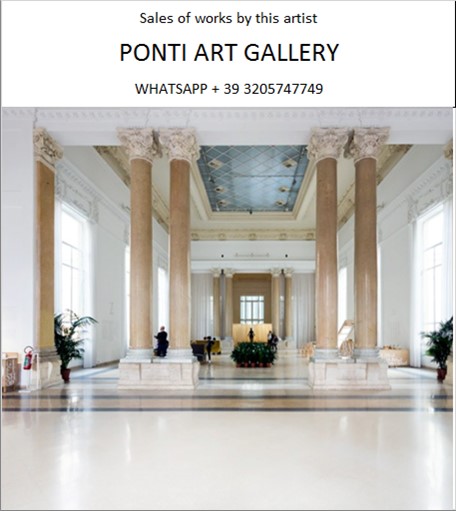Ponti Art Gallery is interested in buying and selling works
of art by this artist.

Massimo Campigli Biography
Massimo Campigli, born Max Ihlenfeld on July 4, 1895, in Berlin, Germany, was an Italian painter and journalist renowned for his unique artistic style that blended elements of ancient art with modern sensibilities. His life and work spanned several pivotal moments in 20th-century art, reflecting the tumultuous changes of his times and his deep engagement with the cultural and historical currents of the Mediterranean world.
Campigli's early years were marked by movement and change. Shortly after his birth, his young German mother, seeking to avoid a family scandal, fled to Italy with him. In 1898, she married a British citizen based in Florence, and they raised Massimo as their nephew. It was only at the age of 15 that Campigli discovered the truth about his origins, a revelation that would later influence his complex relationship with identity and belonging. Despite these early upheavals, Campigli remained close to his family, though he was sensitive about his background.
In 1909, the family moved to Milan, where Campigli was exposed to the vibrant artistic and intellectual circles of the city. He contributed texts and drawings to the avant-garde newspaper "Lacerba" and became acquainted with leading figures of the Futurist movement, such as Boccioni and Carrà. His experiences during World War I, where he served in the Italian army on the Austrian front and was later captured and held as a prisoner of war in Hungary, profoundly impacted him. After escaping to Bucharest and then London, Campigli finally settled in Paris in 1919 as a correspondent for the Italian newspaper "Corriere della Sera."
Paris in the 1920s was a crucible of artistic innovation, and it was here that Campigli's career as a painter began in earnest. He mingled with artists like Giorgio de Chirico, Gino Severini, and Filippo De Pisis at the Café du Dôme and was influenced by the works of Fernand Léger and the classical touches of Picasso. His early paintings reflected the influence of Cubism and Metaphysical painting, but a visit to the Villa Giulia in Rome in 1928 marked a turning point in his artistic direction. Captivated by the Etruscan collection, Campigli began to explore themes and styles inspired by ancient Mediterranean art, including Cretan, Pompeian, Coptic, and Etruscan influences.
Throughout the 1930s and 1940s, Campigli's work gained recognition and was exhibited in major cities across Europe and the United States. His paintings often featured stylized, monumental female figures, reflecting his fascination with the archetypal and the timeless. These figures were set in narrow, hieratic spaces, imbuing them with a sense of solemnity and mystery. Campigli's palette was characterized by muted, earthy tones, which added to the ancient feel of his work.
During World War II, Campigli returned to Italy, living between Venice and Milan. The post-war years saw him dividing his time between Paris, Milan, Rome, and Saint-Tropez, continuing to exhibit widely and receiving critical acclaim. His work from this period showed a further abstraction, with figures reduced to colored markings on almost abstract canvases.
Campigli's contributions to art were not limited to painting. He was also active in the creation of graphic artworks, illustrating several books and writing critical and autobiographical essays. His exploration of ancient themes and his unique synthesis of modernist and archaic elements made him a distinctive voice in 20th-century art.
Massimo Campigli passed away on May 31, 1971, in Saint-Tropez, France, leaving behind a rich legacy that continues to captivate and inspire. His work is held in major museum and private collections around the world, testament to his enduring appeal and the universal resonance of his artistic vision.
Massimo Campigli Quotes and
Sales of Works
Ponti Art Gallery selects and deals with paintings by the
artist. Upon request, we provide free estimates and
evaluations, communicate prices, quotations, and current
market values.
If you are interested in BUYING or SELLING works by the
artist, contact us immediately.
If you wish to sell or receive an evaluation of the
works:
Send us a frontal photo of the painting, one of the back,
and one of the signature. Also, indicate the dimensions of
the work. Inform us about the purchase origin of the work
and any kind of available documentation (purchase
receipts, certificates of authenticity, publications). One
of our operators will respond to you on the same day. We
guarantee maximum confidentiality and extreme
professionalism.
If you wish to purchase works by the painter: Contact us
and let us know your request. We will inform you about the
available works. We also offer the possibility to
subscribe to our NEWSLETTER, through which you will be
informed at the beginning of each month about the latest
acquisitions of the art gallery.
You can send us pictures of the work:
